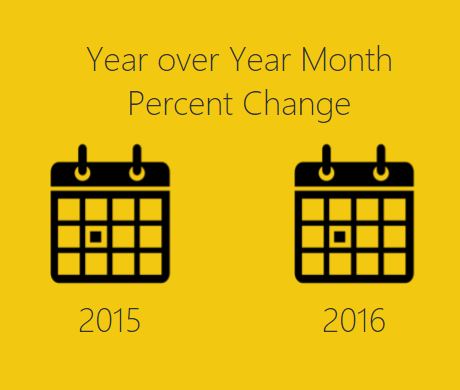How To Calculate Year On Year Percentage Change Pandas

This tutorial is a variation on the month to month per centum change tutorial. This specific exploration in year over year performance was born out of reviewing my google analytics information. The specific analysis question I am trying to respond is, how did this current month of website visitors compare to the aforementioned month final yr. For example I want to compare the number of visitors for November 2016 to November 2015. Did I have more users this year in this calendar month or concluding yr? What was my percent changed between the 2 months?
Here is a sample of the analysis:
let'south begin with loading our data and data transformations. Open up PowerBI Desktop, Click theGo Data button on theDomicile ribbon and selectBlank Query .ClickConnect to open the Query Editor. Click AdvancedEditor on theViewribbon. While in the Avant-garde Editor paste the post-obit code into the editor window, clickDone to complete the data load.
Annotation: If y'all need some more help loading the data follow this tutorial about loading information using the Avant-garde Query Editor. This tutorial teaches yous how to copy and paste M code into the Advanced Editor.
permit Source = Table.FromRows(Json.Document(Binary.Decompress(Binary.FromText("VdDBDcQwCETRXnyOFMAYcC1W+m9jV8BhfH1ygJ9zBr/8CvEaz+DYNL7nDAFjnWkTTNsUbIqnLfyWa56BOXOagy2xtMB5Vjs2mPFOYwIkikIsWd6IKb7qxH5o+bBNwIwIk622OCanTd2YXPNUMNnqFwomp0XvDTAPw+Q2uZL7QL+SC1Wv5Dpx/lO+Hw==", BinaryEncoding.Base64), Compression.Deflate)), let _t = ((type text) meta [Serialized.Text = true]) in blazon table [#"Start of Month" = _t, Sales = _t]), #"Inverse Type" = Tabular array.TransformColumnTypes(Source,{{"Showtime of Calendar month", type date}, {"Sales", Int64.Type}}), #"Inserted Calendar month" = Table.AddColumn(#"Inverse Type", "Month", each Date.Calendar month([Commencement of Calendar month]), blazon number), #"Inserted Year" = Tabular array.AddColumn(#"Inserted Month", "Year", each Engagement.Yr([Get-go of Month]), type number) in #"Inserted Year" While still in the Query Editor rename the query toInformation. Then clickClose & Apply to complete the data load into the data model.

Next, brand 4 measures. On theDwelling house ribbon click theNew Measure button. Enter the following to establish a reference appointment to the subsequent equations:
Date Reference = DATE(2016,12,31)
Enter in the following equation to calculate the last year monthly sales amount.
LastYear = VAR CurrentDate = [Appointment Reference] Return CALCULATE( SUM(Data[Sales]), Data[Year] = YEAR(CurrentDate)-1 )
Annotation: Using the At present() function calls the current time when the query was last run. Thus, if you refresh your information adjacent month the At present() function wrapped in a YEAR() will return the electric current year from the date-fourth dimension observed by PowerBI.
Following the aforementioned process enter the following boosted measures. TheThisYear mensurate calculates the sales for the current calendar month.
ThisYear = VAR CurrentDate = [Appointment Reference] RETURN CALCULATE(SUM(Data[Sales]),Data[Year] = Twelvemonth(CurrentDate))
Finally, add together the calculation for the Year to Year comparison.
YoY Percent Modify = DIVIDE([ThisYear], [LastYear], 0)-one
Since the YoY Pct Change is a real percent we demand to change the formatting to a percentage. Click on the YoY Percentage Change measure then on theModeling ribbon click the%symbol in the formatting section of the ribbon.

Adjacent, add together aStacked Column Chart with the following columns selected.

OK, we have a chart, but it is kinda awkward looking right now. The x-centrality is the month number but we don't have a month 0. That simply does non make sense. Let'south modify some of the chart properties. While having the Stacked Column Chart selected click on thePaint Roller in the Visualizations pane. Kickoff, click on theX-Axisand alter the Type toChiselled.
Then click on theInformation Colors and turn onDiverging. Change theMinimum color to Red and theMaximumcolor to Green. Set theCenter to a value of 0.

Click on theTitle modify it something meaningful,Center the text and increase the font size.
Our bar chart looks much better. All the same, the month numbers do not look quite correct. Visually the month indicators would be cleaner if nosotros didn't accept whatsoever decimals. Click on the Month field and so on theModeling ribbon change the Data Blazon toWhole Number. There will be a alarm letting yous know that you are irresolute the Information Type of the Whole number. ClickOK to proceed with the change.

Another successful percent modify tutorial completed. I promise you enjoyed this year over year month comparison example. Make sure you share if you like what yous run across.
Source: https://powerbi.tips/2016/12/measures-year-over-year-percent-change/
Posted by: davisandessaint.blogspot.com

0 Response to "How To Calculate Year On Year Percentage Change Pandas"
Post a Comment